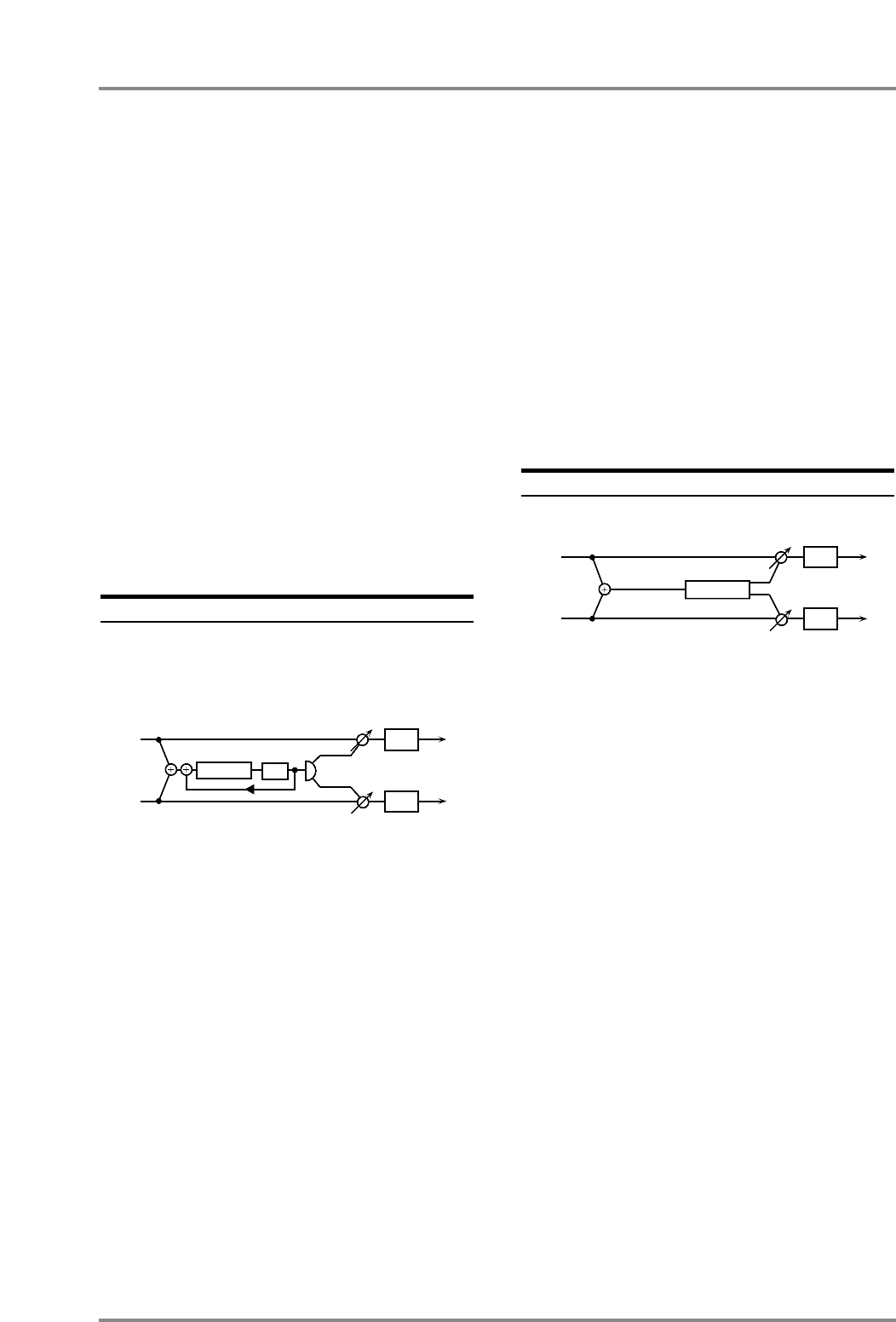
+Feedback (Feedback level) -98% - +98% [9]
Adjust the proportion (%) of the Dlay 1 sound that is
fed back into the effect. Negative (-) settings will
invert the phase.
HF Damp 315 - 8k/Bypass [10]
This adjusts the frequency at which the high range
is cut when the Delay 1 sound is returned to the
input. If you do not wish to cut the high range, set
this to Bypass.
#Balance (Effect balance) D> 0E - D 0<E [16]
Adjust the volume balance between the direct and
the processed sound.
“D” or “E” on the display respectively means
D(direct sound) or E(effect sound) values of 100.
Low Gain -12 - +12 [17]
Adjust the gain of the low frequency range.
Hi Gain (High gain) -12 - +12 [18]
Adjust the gain of the high frequency range.
Level (Output level) 0 - 127 [20]
Adjust the output level.
25: Tm Ctrl Delay (Time control delay) [01H, 54H]
This effect allows you to use a specified controller (the
controller selected in EFX C.Src display (p.92) to con-
trol the delay time and pitch in realtime. Lengthening
the delay time will lower the pitch, and shortening it will
raise the pitch.
+Dly Time (Delay time) 200m - 990m/1sec [1]
Adjust the time delay from the direct sound until
when each delay sound is heard.
Accel (Acceleration) 0 - 15 [2]
This parameter adjusts the speed over which the
Delay Time will change from the current setting to a
newly specified setting. The rate of change for the
Delay Time directly affects the rate of pitch change.
#Feedback (Feedback level) -98% - +98% [3]
Adjust the proportion (%) of the processed sound
that is fed back into the effect. Negative (-) settings
will invert the phase.
HF Damp 315 - 8k/Bypass [4]
Adjust the frequency above which sound fed back
to the effect will be cut. If you do not wish to cut the
high frequencies of the feedback, set this parameter
to Bypass.
EFX Pan (Effect output pan) L63 - 0 - R63 [5]
Adjust the stereo location of the processed sound.
L63 is far left, 0 is center, and R63 is far right.
Balance (Effect balance) D> 0E - D 0<E [16]
Adjust the volume balance between the direct and
the processed sound.
“D” or “E” on the display respectively means
D(direct sound) or E(effect sound) values of 100.
Low Gain -12 - +12 [17]
Adjust the gain of the low frequency range.
Hi Gain (High gain) -12 - +12 [18]
Adjust the gain of the high frequency range.
Level (Output level) 0 - 127 [20]
Adjust the output level.
26: Reverb [01H, 55H]
The Reverb effect adds reverberation to the sound,
simulating an acoustic space.
Type (Reverb type)
Room1/2/Stage1/2/Hall1/2 [1]
Select the type of Reverb effect.
Room1 : dense reverb with short decay
Room2 : sparse reverb with short decay
Stage1 : reverb with greater late reverberation
Stage2 : reverb with strong early reflections
Hall1 : reverb with clear reverberance
Hall2 : reverb with rich reverberance
Pre Dly (Pre delay time) 0 - 100m [2]
Adjust the time delay from when the direct sound
begins until the reverb sound is heard.
+Time (Reverb time) 0 - 127 [3]
Adjust the time length of reverberation.
HF Damp 315 - 8k/Bypass [4]
Adjust the frequency above which the reverberant
sound will be cut. As the frequency is set lower,
more of the high frequencies will be cut, resulting in
a softer and more muted reverberance. If you do
not want the high frequencies to be cut, set this
parameter to Bypass.
#Balance (Effect balance) D> 0E - D 0<E [16]
Adjust the volume balance between the direct and
the processed sound.
“D” or “E” on the display respectively means
D(direct sound) or E(effect sound) values of 100.
L
R
Balance
Delay
HF
Pan
EQ
EQ
L
R
Balance
EQ
EQ
Reverb
Chapter 4. Insertion Effects
67


















